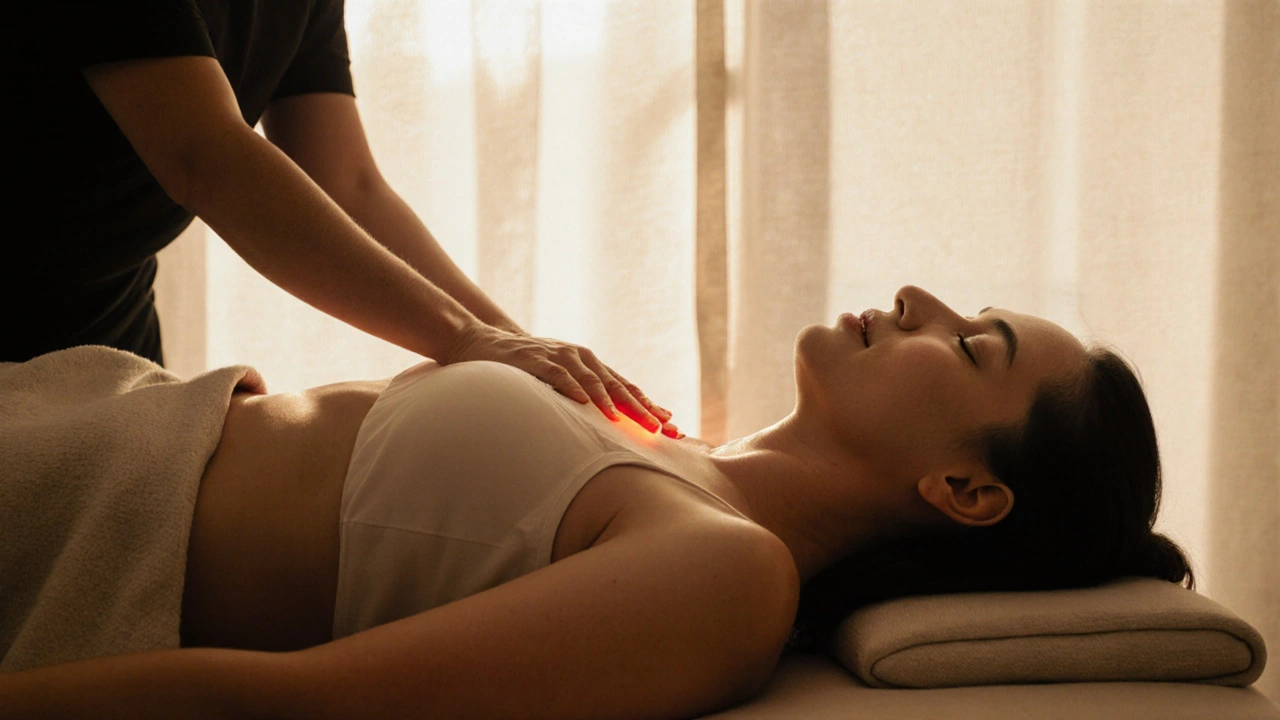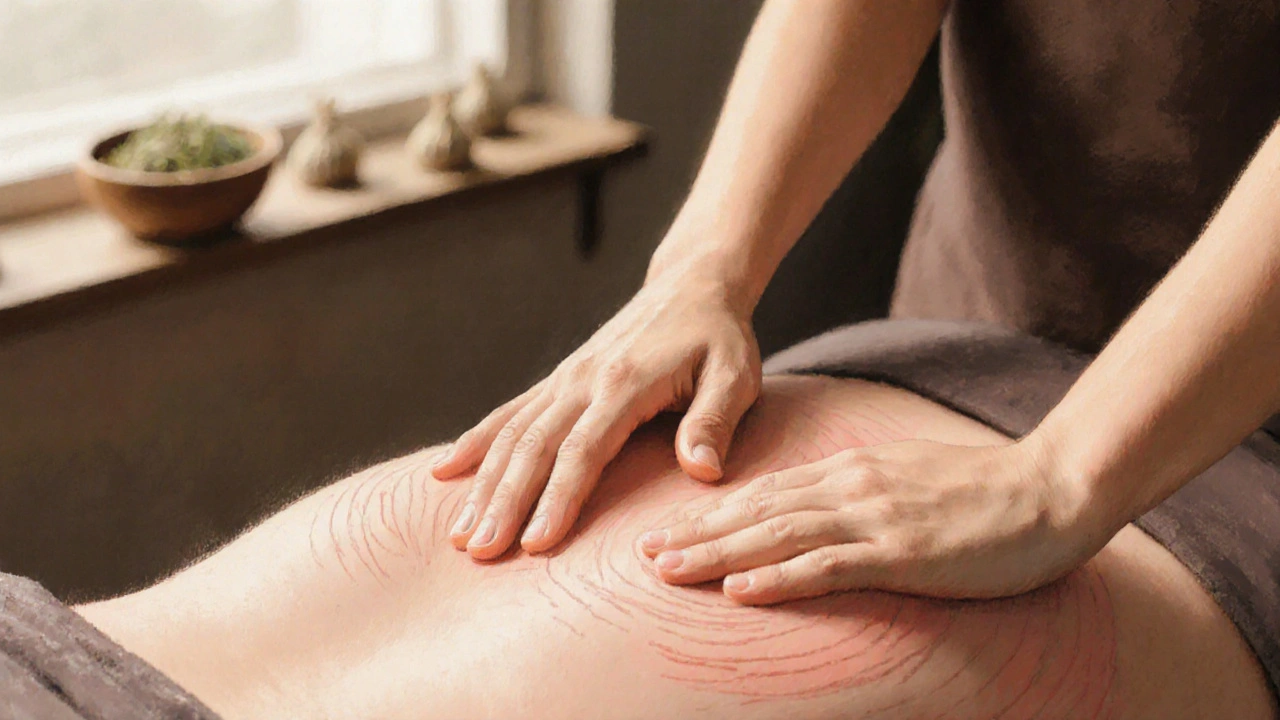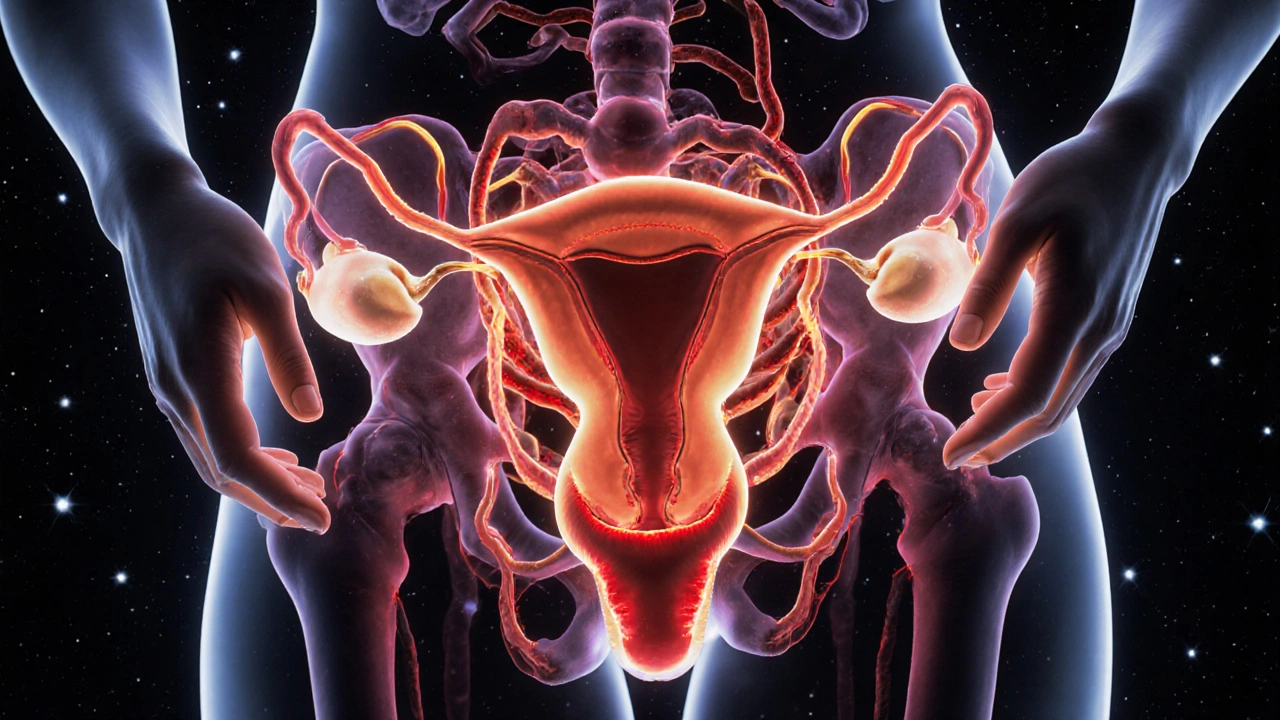Experience the Power of Maya Abdominal Massage for Digestion, Hormones, and Pelvic Health
 Nov, 15 2025
Nov, 15 2025
Maya Abdominal Massage Self-Assessment Tool
Symptom Assessment
Select any symptoms you're experiencing:
Medical History Check
Indicate any conditions that might be contraindications:
Most people think of massage as something for sore shoulders or tight necks. But what if the key to better digestion, fewer cramps, balanced hormones, and even easier childbirth lies not in your back or legs-but in your abdomen?
What Is Maya Abdominal Massage?
Maya abdominal massage, also known as Arvutzi or Abdominal Therapy, is a 3,000-year-old technique passed down through generations of Mayan healers in Central America. Unlike typical massage that targets muscles, this method works with the internal organs-especially the uterus, ovaries, bladder, and intestines-using gentle, rhythmic pressure to reposition and stimulate them.
It’s not about deep tissue or kneading. It’s about guiding organs back into their natural alignment. When your uterus shifts forward or sideways-common after childbirth, surgery, or years of poor posture-it can pull on ligaments, restrict blood flow, and compress nerves. That’s when you get chronic lower back pain, irregular periods, painful cramps, or even infertility. Maya abdominal massage gently lifts and supports these organs, restoring their function.
Women make up the majority of those seeking this therapy, but men benefit too. Prostate congestion, chronic constipation, and post-surgical adhesions can all be eased with this approach.
How It Works: The Science Behind the Touch
The abdomen is packed with organs, nerves, and blood vessels. When organs drop, twist, or stick together due to scar tissue or muscle tension, circulation slows. Reduced blood flow means less oxygen, fewer nutrients, and slower toxin removal. That’s why so many people with digestive issues-bloating, IBS, constipation-feel better after just one session.
Studies from the University of Arizona’s Center for Integrative Medicine show that abdominal massage improves intestinal motility by up to 40% in patients with chronic constipation. Another 2023 trial in Mexico found that 78% of women with endometriosis reported reduced pain after eight weekly sessions of Maya abdominal massage, compared to only 22% in the control group.
The technique uses five key strokes: lifting, circling, sweeping, rocking, and holding. Each movement is slow, intentional, and never forced. Practitioners feel for tension, warmth, and movement beneath the skin. They’re not just touching-you’re feeling the pulse of your own internal organs.
Who Benefits Most?
This isn’t a one-size-fits-all remedy. But certain conditions respond remarkably well:
- Women with painful or irregular periods
- Those struggling with infertility or trying to conceive
- Postpartum women recovering from C-sections or vaginal births
- People with chronic bloating, constipation, or IBS
- Individuals with pelvic pain, sciatica, or lower back issues linked to organ position
- Men with prostate discomfort or urinary retention
One client in Sydney, a 42-year-old teacher, had been on birth control for 15 years to manage cramps. After three sessions of Maya massage, her cycle normalized. She stopped the pill and hasn’t had a single painful period since. Another client, a 58-year-old man with recurring urinary infections, saw his symptoms vanish after five sessions. His doctor couldn’t explain it-but the massage had freed his bladder from adhesions caused by an old hernia repair.
What Happens During a Session?
First, you lie on your back, fully clothed. The practitioner asks about your medical history-surgeries, births, bowel habits, menstrual patterns. Then, they place their hands lightly on your lower abdomen. No oils, no undressing.
They begin by warming the skin with gentle circular motions. Then, they feel for areas of tightness, coolness, or resistance. One spot might feel like a knot under your skin-that’s likely a stuck ligament or scar tissue. They apply sustained, upward pressure to release it. You might feel a warm pulse, a gurgle, or even a small sigh. That’s your body letting go.
Most sessions last 45 to 60 minutes. The first one might feel strange, even emotional. Many people cry without knowing why. That’s normal. Your body holds trauma, stress, and memories in its tissues. This massage doesn’t just move organs-it moves energy.

What You Can Expect After
Right after your session, you might feel tired. Some people need to nap. Others feel a sudden surge of energy. You may notice:
- More frequent urination or bowel movements
- Light spotting (especially if you’re menstruating)
- A sense of lightness in your pelvis
- Improved sleep
- Reduced bloating within 24 hours
For lasting results, most people need 3 to 6 sessions spaced one week apart. After that, monthly maintenance helps keep things in place. Think of it like chiropractic care-but for your insides.
Myths and Misconceptions
There’s a lot of confusion around this technique.
Myth: It’s just a fertility treatment.
Truth: While it’s powerful for conception, it helps anyone with pelvic or digestive dysfunction-even if you’ve had a hysterectomy.
Myth: It’s only for women.
Truth: Men benefit from improved bladder function, reduced prostate swelling, and better digestion. One man in Brisbane, after a prostate surgery, used this massage to avoid a second operation.
Myth: It’s spiritual or mystical.
Truth: While it’s rooted in ancient tradition, the effects are physical. Organs move. Blood flows. Nerves relax. You don’t need to believe in energy channels to feel the difference.
How to Find a Qualified Practitioner
This isn’t something you should try with just anyone. Many spas offer "abdominal massage"-but if they’re using oils, deep pressure, or don’t ask about your medical history, they’re not doing Maya massage.
Look for someone trained by the Maya Abdominal Therapy Institute or certified by the International Association of Maya Abdominal Therapists. Ask:
- What’s your training background?
- Do you work with post-surgical clients?
- Can you explain how you assess organ position?
In Australia, practitioners are rare but growing. Sydney, Melbourne, and Brisbane have certified therapists. Check the official directory at mayaabdominaltherapy.org (no link needed-just search the name).

Can You Do It Yourself?
Yes-but only after learning from a professional. Self-massage is great for maintenance, not correction.
Here’s a simple daily routine:
- Warm your hands by rubbing them together.
- Place them just below your navel.
- Use gentle, upward pressure to lift the area toward your ribs.
- Hold for 5 seconds, then release.
- Move your hands in slow circles clockwise around your lower belly for 2 minutes.
- Repeat once in the morning and once before bed.
Do this for 21 days. You’ll likely notice less bloating and better bowel movements. But if you have a hernia, recent surgery, or are pregnant, skip self-massage and see a professional first.
What to Avoid
Maya massage is safe-but not always appropriate.
- Don’t do it during active menstruation if you have heavy bleeding.
- Avoid it if you have an IUD inserted less than 6 weeks ago.
- Wait at least 6 months after C-section or abdominal surgery.
- Never do it if you have cancer in the pelvic area.
Always consult your doctor if you’re unsure. This isn’t a replacement for medical care-it’s a powerful complement.
Why This Matters Now
In a world where we treat symptoms with pills, Maya abdominal massage brings us back to the body’s natural intelligence. It doesn’t mask pain-it fixes the cause. No drugs. No surgery. Just touch, timing, and trust in your body’s ability to heal.
More women are rejecting the idea that painful periods, bloating, or infertility are "just part of being female." They’re seeking solutions that honor their biology-not override it. Maya massage gives them that power.
Is Maya abdominal massage painful?
No, it shouldn’t be. The pressure is gentle and never forced. You might feel a brief discomfort if there’s a lot of scar tissue, but it should never hurt. If it does, tell your practitioner immediately. This isn’t deep tissue massage-it’s about guiding, not forcing.
How long until I see results?
Some people feel a difference after one session-less bloating, better sleep, lighter pelvic pressure. For deeper issues like endometriosis, infertility, or chronic constipation, most need 3 to 6 sessions. Consistency matters more than intensity.
Can men benefit from Maya abdominal massage?
Absolutely. Men often come in for prostate discomfort, urinary issues, or post-surgical recovery. The massage helps release adhesions around the bladder and prostate, improves circulation, and reduces inflammation. It’s not just a women’s therapy-it’s a pelvic health tool for everyone.
Can I do this if I’ve had a hysterectomy?
Yes. Even without a uterus, your bladder, bowel, and ligaments can still shift. Maya massage helps prevent organ prolapse, reduces scar tissue adhesions, and improves pelvic circulation. Many women who’ve had hysterectomies report less lower back pain and better digestion after treatment.
Is Maya abdominal massage the same as a fertility massage?
Fertility massage is often a simplified version of Maya abdominal massage, focused mainly on the reproductive organs. Maya massage is broader-it includes digestion, bladder function, and overall pelvic alignment. If you’re trying to conceive, Maya massage is the full-spectrum approach. It doesn’t just prepare your womb-it prepares your whole system.
Next Steps
If you’ve been living with bloating, cramps, or pelvic discomfort, don’t accept it as normal. Your body is trying to tell you something. Maya abdominal massage isn’t magic-it’s mechanics. It’s the body’s way of saying: "I can heal, if you just give me the right support."
Start by finding a certified practitioner. Try one session. See how your body responds. You might be surprised at what’s been hidden beneath the surface-and how much lighter you can feel when it’s finally in place.
